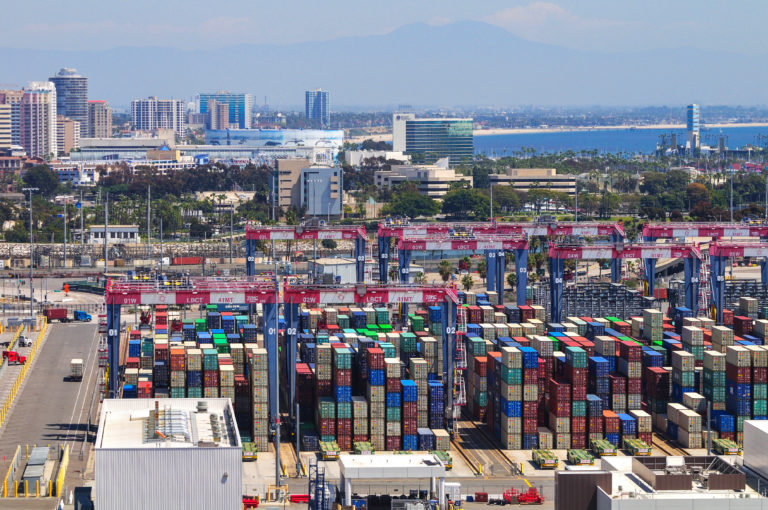
If you ask folks at the Port of Long Beach, things are looking up. Terminal operators and dockworkers there moved 628,205 twenty-foot-equivalent units last month, a 9.5% increase compared to May 2019.
“We aren’t out of the woods, but this is the gradual growth we have anticipated as the United States starts to rebound from the devastating economic impacts of Covid-19 and the trade war with China,” Long Beach Harbor Commission President Bonnie Lowenthal said in a statement.
The Port of Los Angeles, meanwhile, reported moving 581,665 TEUs last month, a 29.8% year-over-year decrease.
“It’s the slowest May since the Great Recession of 2009,” Port of Los Angeles Executive Director Gene Seroka said during a video press briefing last week. “We received and worked on 60 vessels compared to 89 ships last May.”
Imports at the Port of Los Angeles decreased 28.4% to 306,323 TEUs, while exports were down 37.6% to 104,382 TEUs. The volume of empty containers shipped back overseas dropped 26.8% to 170,960 TEUs.
Several factors contributed to the declines, Seroka said, including the pandemic that slowed U.S. manufacturing and consumer purchasing, the continued negative impact of the trade war with China, and a shift of some vessel services from the Port of Los Angeles to its neighbor in Long Beach that amounted to “about 10% of our normal business traffic.”
Seroka also said June cargo volumes are tracking about 14% behind June 2019, and he predicts that about 15% of imports will not return to the port due to new trade policies.
When asked about his outlook on the upcoming peak shipping season, Seroka refrained from providing guidance.
“The uncertainty is just too great,” he said. “We don’t know how fast the American economy can reemerge, how quickly consumers can be out to the stores and our restaurants with normal or reemerging buying patterns like we’ve witnessed in the past, and with some of the states also seeing increased diagnoses of Covid-19 as they’ve begun to reopen, it’s given me quite a bit of a pause. … We just don’t have enough certainty yet to be able to predict what that looks like.
“We’ve missed the spring fashion season. … and the demand signals right now are that we won’t see anything of a really quick recovery and additional cargo volume in the coming two months,” Seroka added.
After seven consecutive months of declines, imports at the Port of Long Beach rose 7.6% to 312,590 TEUs. Exports grew 11.6% to 134,556 TEUs while the volume of empty containers increased 11.4% to 181,060 TEUs.
Port of Long Beach Executive Director Mario Cordero attributed the port’s “strong numbers” to the “efforts of our Business Recovery Task Force, which is setting the path for efficient cargo movement and growth.”
The Port of Long Beach moved 2.83 million TEUs during the first five months of 2020, 5.9% less than during the same period in 2019 while the Port of Los Angeles is tracking about 19% behind the year ago period with 3.07 million TEUs.
The Los Angeles Board of Harbor Commissioners on June 4 approved a $1.5 billion budget for fiscal 2020-2021, which assumes a year-over-year decrease of 7.9% in operating revenues to $460.1 million; operating expenses of $277.8 million; about $837 million in unappropriated funds; and a net loss of $4.8 million.
The budget also earmarked $163.6 million for a capital improvement program that will provide $60.9 million for terminal improvement projects; $54.3 million for public access and environmental enhancement projects in the San Pedro and Wilmington Waterfront areas; $7.8 million each for security-
related and transportation improvement projects at the port; and $33 million for upgrades to Harbor Department facilities and replacement of pilot boats.
Fiscal 2020 for the Port of Long Beach started on Oct. 1. It operates on a $677.5 million budget that includes $390.5 million in capital expenditures.
